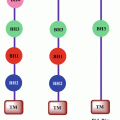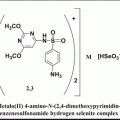© Springer International Publishing Switzerland 2015
Varsha Gandhi, Kapil Mehta, Rajesh Grover, Sen Pathak and Bharat B. Aggarwal (eds.)Multi-Targeted Approach to Treatment of Cancer10.1007/978-3-319-12253-3_1111. Gall Bladder Cancer: What Needs to Be Done in India?
(1)
Sanjay Gandhi Post-graduate Institute of Medical Sciences (SGPGIMS), Lucknow, 226014, UP, India
Abstract
Gall bladder cancer (GBC), uncommon in the West, is common in north India. The Indian Council of Medical Research (ICMR) Cancer Registry needs to be expanded to include more cities in north India. Whether any specific types of gallstones carry higher risk of GBC needs to be investigated. Natural history of asymptomatic gall stones in a high GBC incidence area needs to be studied. The role of PET scan in staging has to be established. Results of major resections in terms of mortality and survival in Indian settings are awaited. Pathologists need to use a standardized proforma to report GBC. Web based multi-institutional databases need to be generated and a national GBC biobank has to be created. There is an urgent need to establish an Indian GBC Consortium.
Keywords
Gall bladder cancerGallstonesIndia11.1 Epidemiology
Gall bladder cancer (GBC), though an uncommon cancer overall, is the commonest cancer of the biliary tract worldwide, but has not received much attention, not even as much as its less common ‘cousin’ cholangiocarcinoma, probably because it is uncommon in the West, including the USA, the UK and western Europe, and Australia and New Zealand. GBC is more common in Central and South America, central and eastern Europe, Japan and north (but not south) India. In Delhi in north India, GBC is the fourth most common (following breast, cervix and ovary) cancer and the commonest gastrointestinal cancer in women (NCRP 2002); clinical experience suggests that GBC is probably even more common in Lucknow, Varanasi and Patna in north India than in Delhi. The exact magnitude of the problem in India, especially in north India, needs to be better documented – the Indian Council of Medical Research (ICMR) Cancer Registry currently covering Delhi only needs to be expanded to include at least Chandigarh, Lucknow, Varanasi and Patna (all in north India) for GBC.
GBC is common in the entire northern part of the Indian subcontinent including Pakistan, northern and north-eastern states of India, Nepal and Bangladesh. There are reports documenting higher incidence of and mortality from GBC in South Asian immigrants in the USA (Jain et al. 2005), the UK (Mangtani et al. 2010) and other countries (Kapoor and McMichael 2003); this needs to be further studied.
11.2 Etio-pathogenesis
Gallstones (GS) have the most important association with GBC; GS are present in >90 % of patients with GBC in Chile, in 60–70 % of patients with GBC in India and in 50–60 % of patients with GBC in Japan. The incidence rates of GBC parallel the prevalence rates of GS in most parts of the world. GS are, however, common in the West but GBC is uncommon. Also, a very small number of patients with GS go on to develop GBC. Gallstones in north India where GBC is very common are different from those in south India where GBC is uncommon. It is, therefore, important to find out if any types of GS increase the risk of GBC. We have standardized the technique of estimation of various components of GS by NMR spectroscopy in vitro and have found some differences between ‘benign’ and ‘malignant’ GS (Sonkar et al. 2013). We would like to study these differences in GS obtained from patients with GBC from other geographical areas and in other ethnic groups also.
Various hypotheses proposed so far for etio-pathogenesis of GBC, viz., heavy metals (Basu et al. 2013), pesticides (Shukla et al. 2001), etc., need to be further studied. This will need collaboration with toxicologists (carcinogens), environmentalists (carcinogens in water and soil) and zoologists (carcinogens in fish). The role of diet (Rai et al. 2004) especially mustard oil (Dixit et al. 2013) needs to be looked into.
Chronic infections, e.g. Helicobacter pylori (Mishra et al. 2011), and carrier states, e.g. Salmonella typhi (Tewari et al. 2010), have been implicated in the etio-pathogenesis of GBC – microbiomic studies need to be done to confirm their role.
North Indians as well as native American Indians share not only high incidence rates of GBC (Lemrow et al. 2008) but also a high prevalence of metabolic syndrome including mid body obesity, glucose intolerance, hyperlipidemia and GS – this coincidence needs to be further looked into.
11.3 Biomarkers
The role of tumour markers, e.g. CEA, CA 19–9 and CA 242 (Rana et al. 2012), in serum, bile and tissue for the diagnosis of GBC needs to be established.
11.4 Molecular Biology
Genome-wide association studies (GWAS), whole genome sequencing (WGS), whole exome (which constitutes less than 1 % of the genome) sequencing (WES) and next-generation sequencing (NGS) can help to find out biomarkers for screening and early diagnosis and to identify druggable targets for the management of unresectable and metastatic disease. NGS is preferred as it studies hundreds of pre-identified genes in a single test using a very small amount of DNA which can be obtained even from formalin-fixed paraffin-embedded tissues (FFPETs). It is unlikely that a single biomarker will be useful; most likely a panel of biomarkers will emerge as useful. Both germ line predispositions, e.g. single nucleotide polymorphisms (SNPs) (in blood) and somatic mutations (in cancerous tissue), need to be identified.
Proteomic studies have identified a battery of serum proteins for screening and early diagnosis of pancreatic cancer (Xue et al. 2012) – similar studies can be done in GBC also.
Irritation due to GS and inflammation (in the form of chronic cholecystitis (CC) and xanthogranulomatous cholecystitis (XGC)) play an important role in causation of GBC – markers of inflammation need to be studied.
Circulating serum microRNAs are good biomarkers for cancer (Redova et al. 2013) and should be evaluated for GBC also.
GBC is one of the few cancers more common in women than in men. Some studies have implicated the role of hormonal factors in the etio-pathogenesis of GBC (Srivastava et al. 2012). Hormonal profile (menstrual, obstetric and lactational history), hormone levels and hormone receptors need to be studied.
11.5 Staging
Computed tomography (CT) scan and staging laparoscopy are essential for staging of GBC (Agrawal et al. 2005; Agrawal 2013). The role of PET scan (after CT scan and before laparoscopy) in staging of GBC has to be established; all PET-positive lesions, however, need to be confirmed by FNAC because of false-positive results caused by inflammation, especially tuberculosis (Kumar et al. 2012).
11.6 Surgery
Our group has advocated a ‘Buddhist’ Indian middle path between the western pessimism and Japanese aggressivism towards surgical management of GBC (Kapoor 2007). Some Indian groups, however, perform major resections, e.g. extended right hepatectomy and hepato-pancreaticoduodenectomy, in patients with locoregionally advanced GBC, but no large experiences and long-term results have yet been published.
11.7 Adjuvant Therapy
Most patients with GBC have recurrence of the disease even after resection; patterns of failure after resectional surgery need to be documented (by at least CT scan and preferably PET scan and FNAC) – they will guide and direct adjuvant therapy, viz., chemotherapy or radiotherapy.
At present, the majority of patients with GBC who have unresectable locoregionally advanced disease are not being offered any treatment. The role of neoadjuvant therapy for borderline resectable GBC needs to be studied. The role of chemoradiotherapy (Sharma et al. 2010) and biological therapy, in palliative setting also needs to be explored.
11.8 Pathology
Proper management of incidental GBC depends to a large extent on pathological details, viz., site of tumour (fundus, body or neck), T stage (depth of involvement of GB wall), status of cystic duct margin, status of cystic lymph node (if included in the cholecystectomy specimen), grade of differentiation and presence of perineural and lymphovascular invasion. There is, therefore, a need for standardization of proforma to be used by the pathologists for histological reporting of GBC.
Stay updated, free articles. Join our Telegram channel

Full access? Get Clinical Tree








